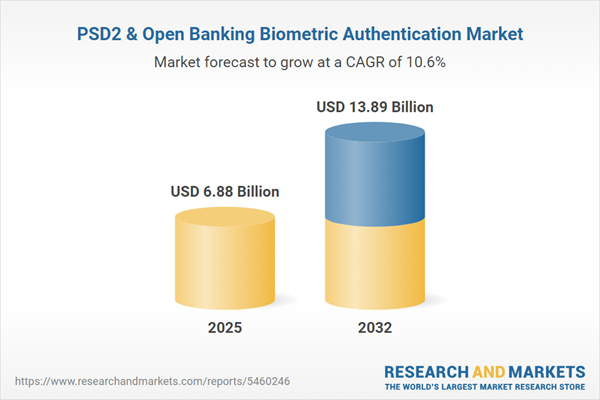Speak directly to the analyst to clarify any post sales queries you may have.
The biometric authentication market under PSD2 and open banking is rapidly transforming digital financial services, propelled by regulatory mandates, technology advances, and shifting consumer expectations. Senior leaders are prioritizing innovative solutions to drive security, compliance, and seamless user experiences across channels.
Market Snapshot: PSD2 & Open Banking Biometric Authentication Market
The PSD2 & Open Banking Biometric Authentication Market grew from USD 6.21 billion in 2024 to USD 6.88 billion in 2025. It is expected to continue growing at a CAGR of 10.57%, reaching USD 13.89 billion by 2032.
The combination of open banking frameworks and strong customer authentication mandates is driving accelerated adoption across banks, fintech firms, and financial service providers. Stakeholders are adapting fast, balancing innovation with compliance and operational efficiency in a market characterized by resilience and sustained growth potential.Scope & Segmentation
- Authentication Methods: Behavioral biometrics, including gait analysis and keystroke dynamics; facial recognition; fingerprint; iris recognition; and voice recognition solutions.
- Deployment Modes: Cloud deployment with private and public cloud models, as well as on-premises installations to meet varying regulatory and operational demands.
- Application Areas: ATM and self-service kiosks, internet banking platforms, mobile banking apps for Android and iOS, and advanced point-of-sale terminals—including both countertop and kiosk interfaces.
- End User Industries: Corporate and retail banking divisions; financial service organizations such as asset management and insurance; fintech entities focused on payment services and wealth technology.
- Organization Sizes: Large enterprises as well as small and medium enterprises each adopting unique strategies for multi-modal biometric authentication.
- Geographic Regions: Americas (including North America, Latin America), Europe, Middle East & Africa, and Asia-Pacific with country-level coverage such as United States, Canada, UK, China, India, among others.
- Leading Companies: Thales S.A., IDEMIA Group, NEC Corporation, Daon Limited, iProov, Accenture, HID Global Corporation, Suprema, Inc., Aware, Inc., BIO-key International, Inc.
Key Takeaways: Strategic Considerations for Market Leaders
- PSD2 regulations and open banking initiatives are establishing biometric authentication as the preferred identity verification standard, reshaping the competitive landscape for financial institutions and technology vendors.
- Behavioral and facial biometrics are gaining momentum with new AI-driven liveness detection, while fingerprint methods continue to dominate due to device compatibility and user familiarity.
- Cloud-based biometrics support rapid deployment and scalability for agile entrants, whereas on-premises solutions are significant for regulated or legacy banking systems.
- Large-scale adoption in Asia-Pacific is being led by progressive identity programs and a strong mobile-first culture, while Europe’s focus on API-driven open banking encourages integration of multi-modal authentication workflows.
- Collaboration between global technology providers, fintech disruptors, and local service experts is driving ecosystem innovation and expansion in both mature and emerging markets.
- Organization size determines the approach—large banks pursue standardized, resilient platforms; smaller firms seek flexible, subscription-based deployment to optimize user experience and compliance.
Tariff Impact: Navigating the U.S. Policy Environment
New U.S. tariffs on biometric hardware in 2025 are prompting businesses to reassess supply chains, prioritize software-driven solutions, and consider nearshore manufacturing partnerships. This climate accelerates a shift towards cloud-centric offerings, puts pressure on procurement strategies, and intensifies competition between legacy hardware providers and agile software-first entrants.
Methodology & Data Sources
This report utilizes a robust research methodology, combining primary interviews with senior banking executives, fintech innovators, and technology suppliers with structured surveys and in-depth workshops. Secondary data, including regulatory filings, industry publications, and vendor case studies, was systematically validated to establish consistent and accurate market insights.
Why This Report Matters
- Gain actionable insights on how biometric authentication is evolving in response to regulatory change, technology advances, and competitive realignment.
- Inform strategic planning with segmentation and regional data, helping leaders tailor deployment and investment to sector-specific needs.
- Anticipate the impact of regulatory, policy, and supply chain dynamics to maintain resilience and leadership in financial authentication.
Conclusion
Biometric authentication is emerging as a foundational element in secure, customer-focused open banking ecosystems. Strategic investment in multi-modal frameworks and adaptive deployment will position financial institutions and technology providers to unlock both compliance and commercial advantage in a changing landscape.
Additional Product Information:
- Purchase of this report includes 1 year online access with quarterly updates.
- This report can be updated on request. Please contact our Customer Experience team using the Ask a Question widget on our website.
Table of Contents
3. Executive Summary
4. Market Overview
7. Cumulative Impact of Artificial Intelligence 2025
Companies Mentioned
The companies profiled in this PSD2 & Open Banking Biometric Authentication market report include:- Thales S.A.
- IDEMIA Group
- NEC Corporation
- Daon Limited
- iProov
- Accenture
- HID Global Corporation
- Suprema, Inc.
- Aware, Inc.
- BIO-key International, Inc.
Table Information
| Report Attribute | Details |
|---|---|
| No. of Pages | 182 |
| Published | October 2025 |
| Forecast Period | 2025 - 2032 |
| Estimated Market Value ( USD | $ 6.88 Billion |
| Forecasted Market Value ( USD | $ 13.89 Billion |
| Compound Annual Growth Rate | 10.5% |
| Regions Covered | Global |
| No. of Companies Mentioned | 11 |









